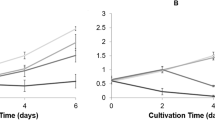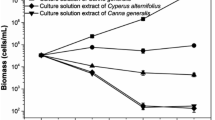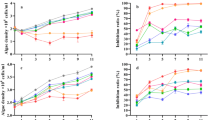Abstract
This paper studied the inhibitory effect of pomegranate peel (PP) extract on the growth of Microcystis aeruginosa, the model of harmful algal blooms in aquatic environment. The allelochemicals were identified by HPLC–MS/MS from PP and tested by batch experiment through measurement of algal density, chlorophyll a (Chl-a) concentration, maximum quantum yield of photosystem II (Fv/Fm), superoxide dismutase (SOD), and malondialdehyde (MDA) contents. Results showed that both PP powder and PP extract had obvious inhibitory effect on M. aeruginosa growth. Quercetin and luteolin were identified as the allelochemicals to M. aeruginosa growth. However, the inhibitory capacity of luteolin was stronger than that of quercetin. The growth inhibition ratio of luteolin can reach up to 98.7 and 99.1% of the control on day 7 at the dosages of 7 and 10 mg/L, respectively. Moreover, the changes of Chl-a, Fv/Fm, SOD, and MDA in M. aeruginosa confirmed jointly that the allelochemicals cause inhibition of photosystem and oxidative damage to M. aeruginosa cells with the antioxidant defense system being activated, which leads to the aggravation of membrane lipid peroxidation. Thus, luteolin could be used as a promising algaecide for emergency handling of M. aeruginosa blooms. This study might provide a new direction in the management of eutrophication in the future.





Similar content being viewed by others
References
Adams LK, Benson EE, Staines HJ, Bremner DH, Millam S, Deighton N (1999) Effects of the lipid peroxidation products 4-hydroxy-2-nonenal and malondialdehyde on the proliferation and morphogenetic development of in vitro plant cells. J Plant Physiol 155(3):376–386
Akhtar S, Ismail T, Fraternale D, Sestili P (2015) Pomegranate peel and peel extracts: chemistry and food features. Food Chem 174:417–425
Ali AA, Alqurainy F (2006) Activities of antioxidants in plants under environmental stress. In: Motohashi N (ed) The lutein—prevention and treatment for diseases. Transworld Research Network, India, pp 187–256
Anderson DM (2009) Approaches to monitoring, control and management of harmful algal blooms (HABs). Ocean Coast Manag 52(7):342
Beauchamp C, Fridovich I (1971) Superoxide dismutase: improved assays and an assay applicable to acrylamide gels. Anal Biochem 44(1):276–287
Busch CJ, Binder CJ (2017) Malondialdehyde epitopes as mediators of sterile inflammation. Biochim Biophys Acta 1862(4):398–406
Chen S, Chen M, Wang Z, Qiu W, Wang J, Shen Y, Wang Y, Ge S (2016) Toxicological effects of chlorpyrifos on growth, enzyme activity and chlorophyll a synthesis of freshwater microalgae. Environ Toxicol Pharmacol 45:179–186
Davey MW, Stals E, Panis B, Keulemans J, Swennen RL (2005) High-throughput determination of malondialdehyde in plant tissues. Anal Biochem 347(2):201–207
Fischer UA, Carle R, Kammerer DR (2011) Identification and quantification of phenolic compounds from pomegranate (Punica granatum L.) peel, mesocarp, aril and differently produced juices by HPLC-DAD-ESI/MS n. Food Chem 127(2):807–821
Glibert PM (2017) Eutrophication, harmful algae and biodiversity—challenging paradigms in a world of complex nutrient changes. Mar Pollut Bull 124(2):591–606
Haroon AM, Abdel-Aal EI (2016) Chemical composition and in vitro anti-algal activity of Potamogeton crispus and Myriophyllum spicatum extracts. Egypt J Aquat Res 42(4):393–404
Hassan HM, Scandalios JG (1990) Superoxide dismutases in aerobic organisms. In: Alscher RG, Cumming JR (eds) Stress responses in plants: adaptation and acclimatation mechanisms. Wiley-Liss, New York, pp 175–199
Hong Y, Hu HY, Xie X, Sakoda A, Sagehashi M, Li FM (2009) Gramine-induced growth inhibition, oxidative damage and antioxidant responses in freshwater cyanobacterium Microcystis aeruginosa. Aquat Toxicol 91(3):262–269
Huang HM, Xiao X, Ghadouani A, Wu JP, Nie ZY, Peng C, Xu X, Shi J (2015) Effects of natural flavonoids on photosynthetic activity and cell integrity in Microcystis aeruginosa. Toxins 7(1):66–80
Huang H, Xiao X, Lin F, Grossart HP, Nie Z, Sun L, Xu C, Shi J (2016) Continuous-release beads of natural allelochemicals for the long-term control of cyanobacterial growth: preparation, release dynamics and inhibitory effects. Water Res 95:113–123
Hung SM, Hsu BD, Lee S (2014) Modelling of isothermal chlorophyll extraction from herbaceous plants. J Food Eng 128:17–23
Kazemi M, Karim R, Mirhosseini H, Abdul HA (2016) Optimization of pulsed ultrasound-assisted technique for extraction of phenolics from pomegranate peel of Malas variety: punicalagin and hydroxybenzoic acids. Food Chem 206:156–166
Ken CF, Hsiung TM, Huang ZX, Juang RH, Lin CT (2005) Characterization of Fe/Mn-superoxide dismutase from diatom Thallassiosira weissflogii: cloning, expression, and property. J Agric Food Chem 53(5):1470–1474
Laue P, Bährs H, Chakrabarti S, Steinberg CEW (2014) Natural xenobiotics to prevent cyanobacterial and algal growth in freshwater: contrasting efficacy of tannic acid, gallic acid, and gramine. Chemosphere 104(3):212–220
Li J, He X, Li M, Zhao W, Liu L, Kong X (2015) Chemical fingerprint and quantitative analysis for quality control of polyphenols extracted from pomegranate peel by HPLC. Food Chem 176:7–11
Li J, Liu Y, Zhang P, Zeng G, Cai X, Liu S, Yin Y, Hu X, Hu X, Tan X (2016) Growth inhibition and oxidative damage of Microcystis aeruginosa induced by crude extract of Sagittaria trifolia tubers. J Environ Sci (China) 43:40–47
Magdaleno A, Velez CG, Wenzel MT, Tell G (2014) Effects of cadmium, copper and zinc on growth of four isolated algae from a highly polluted Argentina river. Bull Environ Contam Toxicol 92(2):202–207
Mallick N, Mohn FH, Rai LC, Soeder CJ (2000) Evidence for the non-involvement of nitric oxide synthase in nitric oxide production by the green alga Scenedesmus obliquus. J Plant Physiol 156(3):423–426
Mihara M, Uchiyama M (1978) Determination of malonaldehyde precursor in tissues by thiobarbituric acid test. Anal Biochem 86(1):271–278
Mu D, Ruan R, Addy M, Mack S, Chen P, Zhou Y (2017) Life cycle assessment and nutrient analysis of various processing pathways in algal biofuel production. Bioresour Technol 230:33–42
Ni L, Jie X, Wang P, Li S, Wang G, Li Y, Li Y, Acharya K (2015) Effect of linoleic acid sustained-release microspheres on Microcystis aeruginosa antioxidant enzymes activity and microcystins production and release. Chemosphere 121:110–116
Pakdel FM, Sim L, Beardall J, Davis J (2013) Allelopathic inhibition of microalgae by the freshwater stonewort, Chara australis, and a submerged angiosperm, Potamogeton crispus. Aquat Bot 110:24–30
Park J, Church J, Son Y, Kim KT, Lee WH (2017) Recent advances in ultrasonic treatment: challenges and field applications for controlling harmful algal blooms (HABs). Ultrason Sonochem 38:326–334
Patino R, Rashel RH, Rubio A, Longing S (2018) Growth-suppressing and algicidal properties of an extract from Arundo donax, an invasive riparian plant, against Prymnesium parvum, an invasive harmful alga. Harmful Algae 71:1–9
Pichierri S, Pezzolesi L, Vanucci S, Totti C, Pistocchi R (2016) Inhibitory effect of polyunsaturated aldehydes (PUAs) on the growth of the toxic benthic dinoflagellate Ostreopsis cf. ovata. Aquat Toxicol 179:125–133
Qu W, Pan Z, Zhang R, Ma HX, Chen ZB, Wang Z, Atungulu GG (2009) Integrated extraction and anaerobic digestion process for recovery of nutraceuticals and biogas from pomegranate marc. Trans ASABE 52(6):1997–2006
Rice EL (1984) Allelopathy, 2nd edn. Academic Press, New York
Shabtay A, Eitam H, Tadmor Y, Orlov A, Meir A, Weinberg P, Weinberg ZG, Chen Y, Brosh A, Izhaki I (2008) Nutritive and antioxidative potential of fresh and stored pomegranate industrial byproduct as a novel beef cattle feed. J Agric Food Chem 56(21):10063–10070
Sun R, Sun P, Zhang J, Esquivel-Elizondo S, Wu Y (2018) Microorganisms-based methods for harmful algal blooms control: a review. Bioresour Technol 248:12–20
Wang R, Wang J, Xue Q, Tan L, Cai J, Wang H (2016a) Preliminary analysis of allelochemicals produced by the diatom Phaeodactylum tricornutum. Chemosphere 165:298–303
Wang R, Hua M, Yu Y, Zhang M, Xian QM, Yin DQ (2016b) Evaluating the effects of allelochemical ferulic acid on Microcystis aeruginosa by pulse-amplitude-modulated (PAM) fluorometry and flow cytometry. Chemosphere 147:264–271
Xi J, He L, Yan LG (2017) Continuous extraction of phenolic compounds from pomegranate peel using high voltage electrical discharge. Food Chem 230:354–361
Yalcin B, Artuz ML, Pavlidou A, Cubuk S, Dassenakis M (2017) Nutrient dynamics and eutrophication in the Sea of Marmara: data from recent oceanographic research. Sci Total Environ 601-602:405–424
Yan RW, Ji YH, Ji HL, Fang YM, Kerr PG, Yang LZ (2011) The decoction of radix Astragali inhibits the growth of Microcystis aeruginosa. Ecotoxicol Environ Saf 74:1006–1010
Yang C, Yang Z, Zhang M, Dong Q, Wang X, Lan A, Zeng F, Chen P, Wang C, Feng J (2011) Hydrogen sulfide protects against chemical hypoxia-induced cytotoxicity and inflammation in HaCaT cells through inhibition of ROS/NF-kappaB/COX-2 pathway. PLoS One 6(7):e21971
Yang Z, Kong F, Shi X, Yu Y, Zhang M (2015) Effects of UV-B radiation on microcystin production of a toxic strain of Microcystis aeruginosa and its competitiveness against a non-toxic strain. J Hazard Mater 283:447–453
Zak L, Kosakowska A (2015) The influence of extracellular compounds produced by selected Baltic cyanobacteria, diatoms and dinoflagellates on growth of green algae Chlorella vulgaris. Estuar Coast Shelf Sci 167:113–118
Zamocky M, Jakopitsch C, Furtmuller PG, Dunand C, Obinger C (2008) The peroxidase-cyclooxygenase superfamily: reconstructed evolution of critical enzymes of the innate immune system. Proteins 72(2):589–605
Zheng H, Sun C, Hou X, Wu M, Yao Y, Li F (2018) Pyrolysis of Arundo donax L. to produce pyrolytic vinegar and its effect on the growth of dinoflagellate Karenia brevis. Bioresour Technol 247:273–281
Acknowledgments
The authors acknowledge Associate Professor Li Tizheng for his selfless help in the statistical analysis of the data.
Funding
This work was funded by the National Natural Science Foundation of China (Grant number 21677115) and the Shaanxi Provincial Natural Science Foundation Research Key Project (2016JZ019).
Author information
Authors and Affiliations
Corresponding author
Additional information
Responsible editor: Vitor Manuel Oliveira Vasconcelos
Publisher’s note
Springer Nature remains neutral with regard to jurisdictional claims in published maps and institutional affiliations.
Rights and permissions
About this article
Cite this article
Chen, L., Wang, Y., Shi, L. et al. Identification of allelochemicals from pomegranate peel and their effects on Microcystis aeruginosa growth. Environ Sci Pollut Res 26, 22389–22399 (2019). https://doi.org/10.1007/s11356-019-05507-1
Received:
Accepted:
Published:
Issue Date:
DOI: https://doi.org/10.1007/s11356-019-05507-1




